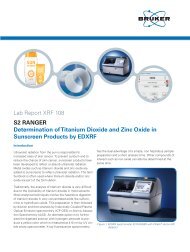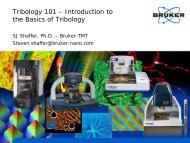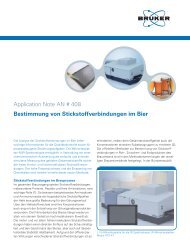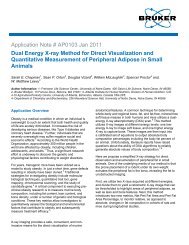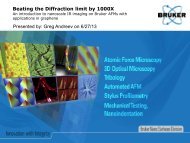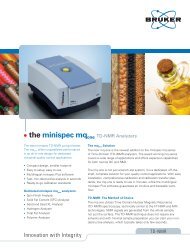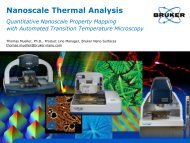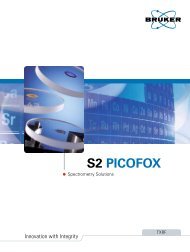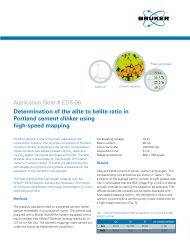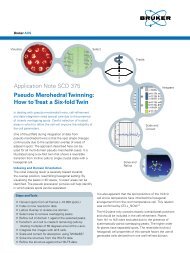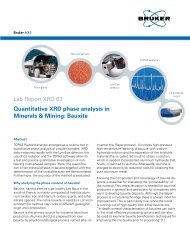Monitoring enzyme catalysis using the VERTEX 80 FT-IR ... - Bruker
Monitoring enzyme catalysis using the VERTEX 80 FT-IR ... - Bruker
Monitoring enzyme catalysis using the VERTEX 80 FT-IR ... - Bruker
Create successful ePaper yourself
Turn your PDF publications into a flip-book with our unique Google optimized e-Paper software.
Application Note AN # 74<strong>Monitoring</strong> <strong>enzyme</strong> <strong>catalysis</strong> <strong>using</strong> <strong>the</strong><strong>VERTEX</strong> <strong>80</strong> <strong>FT</strong>-<strong>IR</strong> spectrometer inRapid Scan modeIntroductionα-chymotrypsin is a well characterised mammalian digestive<strong>enzyme</strong> that catalyses <strong>the</strong> hydrolytic cleavage of peptidebonds at <strong>the</strong> carboxyl side of aromatic residues. During <strong>the</strong>chymotrypsin-catalysed hydrolysis of N-succinyl-Ala-Ala-Pro-Phe-p-nitroanilide (Suc-AAPF-pNA; see figure 1), formationof <strong>the</strong> p-nitroaniline product can be followed spectroscopicallyat 410 nm while <strong>the</strong> peptide product can be monitoredby <strong>FT</strong>-<strong>IR</strong> spectroscopy due to formation of a new C-terminalcarboxylate group. The <strong>VERTEX</strong> <strong>80</strong> <strong>FT</strong>-<strong>IR</strong> spectrometer with<strong>the</strong> UltraScan TM linear air bearing scanner with True-AlignmentTM technology is ideally suited for such kinetic studies,since at <strong>the</strong> fastest mirror velocity (320 kHz) more than 100spectra at resolution 16 cm -1 can be collected per second.Experimentalα-chymotrypsin was purchased from Sigma-Aldrich (St. Louis,MO; catalogue number 27270) and used without fur<strong>the</strong>rpurification. The concentration was determined by ε 2<strong>80</strong>= 5104M -1 cm -1 . We chose to use <strong>the</strong> substrate N-succinyl-Ala-Ala-Pro-Phe-p-nitroanilide (Sigma catalogue number S7388) asit is a ‘good’ substrate with a tight K mand relatively fast k catvalue (see reference 1). Additionally, aqueous solutions of <strong>the</strong>substrate are reasonably soluble to about 15 mM and cleavagecan also be followed spectroscopically in <strong>the</strong> near-UV with ε 315(reactant) = 14000 M -1 cm -1 and ε 410(product) = 8<strong>80</strong>0 M -1 cm -1 .The <strong>FT</strong>-<strong>IR</strong> stopped-flow instrument consists of a drive unit, a<strong>the</strong>rmostatted umbilical supply tube and an infrared cell withan integrated mixer (TgK Scientific, Bradford on Avon, UK)mounted in <strong>the</strong> sample compartment of a <strong>Bruker</strong> <strong>VERTEX</strong> <strong>80</strong><strong>FT</strong>-<strong>IR</strong> spectrometer. The stopped-flow unit and <strong>the</strong> mixing cellare both contained within an anaerobic Belle Technology glovebox, which allows oxygen-sensitive reactions to be performedunder a nitrogen environment containing
eference 2). Briefly, <strong>the</strong> cell is a demountable stainless steelunit with an integrated T-mixer. It has 1.2 cm CaF 2windowsand <strong>the</strong> flow channels are 0.5 mm 2 , toge<strong>the</strong>r creating an8 mm diameter observation chamber with a 100 µm pathlength. The stopped-flow mixing time is < 10 ms and <strong>the</strong>shot volume is variable, with a value of 200 µl used in thisstudy. A photo of <strong>the</strong> apparatus is shown.2 mM α-chymotrypsin was mixed with an equal volume of 15mM Suc-AAPF-pNA in 50 mM potassium phosphate/D 2O,pD 8.4 at room temperature within <strong>the</strong> stopped-flow <strong>FT</strong>-<strong>IR</strong>apparatus. A narrow band MCT detector was used for speedand sensitivity. In addition, a long wave pass optical filter



